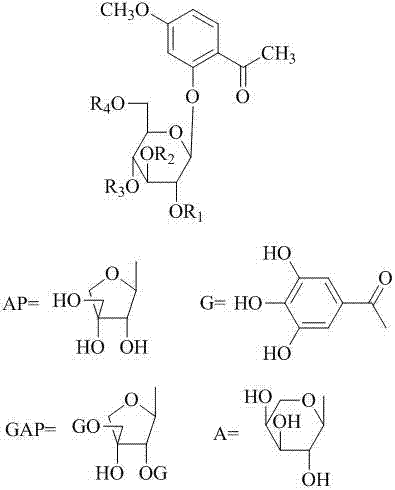Application of phenolic glycoside compounds in anticomplement medicine preparation
A technology of compounds and phenolic glycosides, which is applied in the field of traditional Chinese medicine and pharmaceuticals, and can solve problems such as anti-complement activity that has not yet been seen
- Summary
- Abstract
- Description
- Claims
- Application Information
AI Technical Summary
Problems solved by technology
Method used
Image
Examples
Embodiment 1
[0028] Embodiment 1. Preparation of phenolic glycosides
[0029] Take 20 kg of Cortex paeonol, crush it, soak it with 95% ethanol at room temperature (40 L × 3 times), combine the extracts and concentrate to obtain 2.6 kg of extract, take 1.0 kg of extract, add water to suspend, and successively dilute with equal volume Extract with ethyl acetate and n-butanol (each 2.0 L x 5 times), combine the extracts and concentrate to dryness to obtain 390 g of ethyl acetate extract and 260 g of n-butanol extract. Take the n-butanol extract and add water to suspend it, load the sample on Diaion HP-20 resin, and elute with water, 25%, 50%, 75%, and 100% methanol aqueous solution in sequence to obtain 5 fractions (PS-BU-1 ~5). The fractions (PS-BU-2~4) were repeatedly purified by ODS column chromatography (methanol:water, 25:75-80:20) and Sephadex LH-20 (methanol), and separated by preparative HPLC to obtain the compound paeonol glycoside A (paeonolide A, 1), paeonolide B (paeonolide B, 2...
Embodiment 2
[0036] Example 2. Anti-complement classical pathway test in vitro
[0037] Take 0.1 ml of complement (guinea pig serum), add barbiturate buffer solution (BBS) to make a 1:10 solution, and dilute it to 1:20, 1:40, 1:80, 1:160, 1:10 with BBS 320, 1:640 and 1:1280 solutions. Take 1:1000 hemolysin, 0.1 ml of each concentration of complement and 2% sheep red blood cells (SRBC) and dissolve them in 0.3 ml BBS, mix well, put them in a low-temperature high-speed centrifuge at 5000 rpm, 4 ºC after 30 min in a water bath at 37 ºC Centrifuge for 10 min under conditions. Take 0.2 ml of the supernatant from each tube in a 96-well plate, and measure the absorbance at 405 nm. A full hemolysis group (0.1 ml 2% SRBC dissolved in 0.5 ml triple distilled water) was also set up in the experiment. The absorbance of three-distilled water lysed blood vessels was used as the standard of total hemolysis, and the hemolysis rate was calculated. Plot the dilution of complement on the X-axis and the p...
Embodiment 3
[0038] Example 3. Anti-complement alternative pathway test in vitro
[0039] Take 0.2 ml of complement (human serum), add AP diluent (barbital buffer, pH=7.4, containing 5 mM Mg 2+ , 8mM EGTA) was prepared as a 1:5 solution and double diluted to 1:10, 1:20, 1:40, 1:80, 1:160, 1:320 and 1:640 solutions. Take 0.15 ml of complement of each concentration, 0.15 ml of AP diluent and 0.20 ml of 0.5% rabbit red blood cells (RE), mix well, place in a low-temperature high-speed centrifuge at 5000 rpm and 4 ºC for 10 min in a 37 ºC water bath . Take 0.2 ml of the supernatant from each tube in a 96-well plate, and measure the absorbance at 405 nm. A complete hemolysis group (0.20 ml 0.5% RE dissolved in 0.3 ml triple distilled water) was set up in the experiment. The absorbance of three-distilled water lysed blood vessels was used as the standard of total hemolysis, and the hemolysis rate was calculated. Plot the dilution of complement on the X-axis and the percentage of hemolysis on ...
PUM
 Login to View More
Login to View More Abstract
Description
Claims
Application Information
 Login to View More
Login to View More - R&D
- Intellectual Property
- Life Sciences
- Materials
- Tech Scout
- Unparalleled Data Quality
- Higher Quality Content
- 60% Fewer Hallucinations
Browse by: Latest US Patents, China's latest patents, Technical Efficacy Thesaurus, Application Domain, Technology Topic, Popular Technical Reports.
© 2025 PatSnap. All rights reserved.Legal|Privacy policy|Modern Slavery Act Transparency Statement|Sitemap|About US| Contact US: help@patsnap.com



